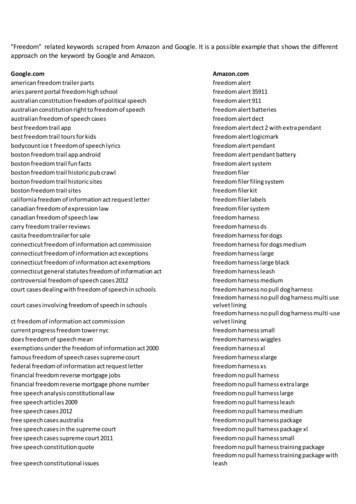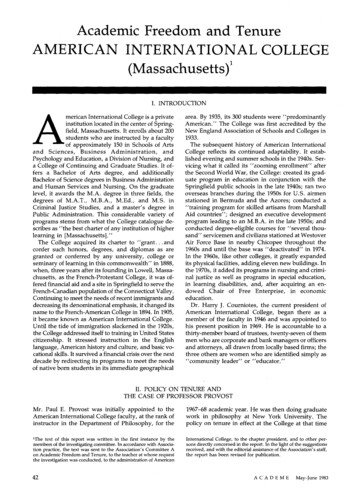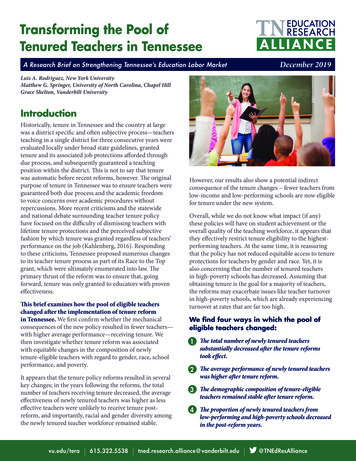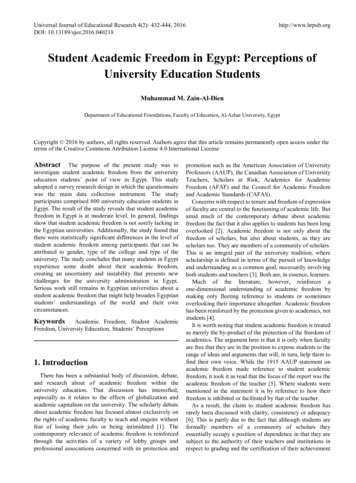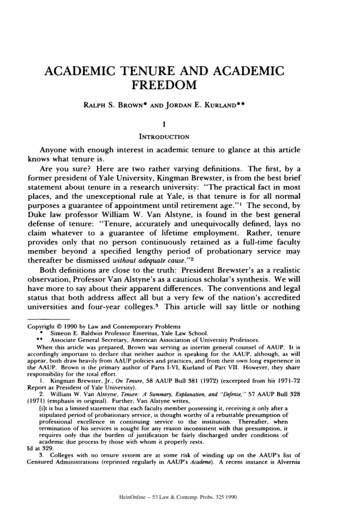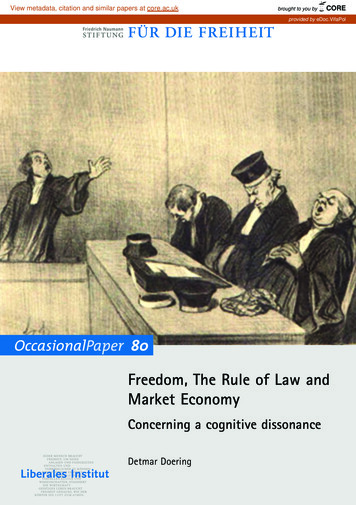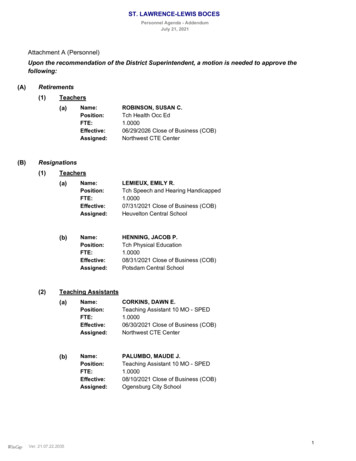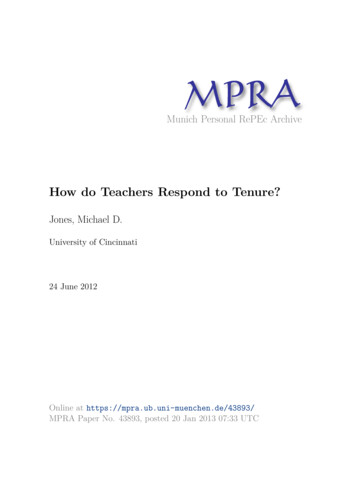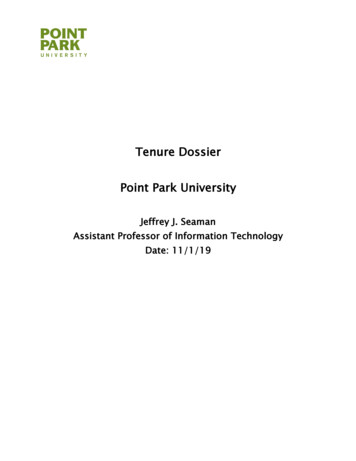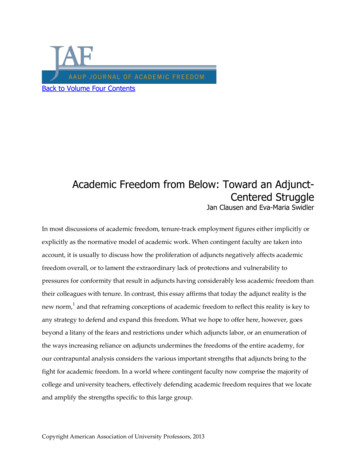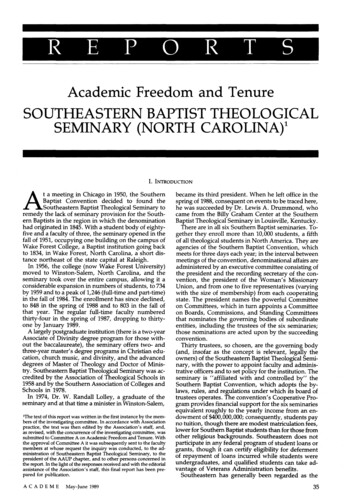
Transcription
Academic Freedom and TenureSOUTHEASTERN BAPTIST THEOLOGICALSEMINARY (NORTH CAROLINA)1I. INTRODUCTIONAt a meeting in Chicago in 1950, the SouthernBaptist Convention decided to found theSoutheastern Baptist Theological Seminary toremedy the lack of seminary provision for the Southern Baptists in the region in which the denominationhad originated in 1845. With a student body of eightyfive and a faculty of three, the seminary opened in thefall of 1951, occupying one building on the campus ofWake Forest College, a Baptist institution going backto 1834, in Wake Forest, North Carolina, a short distance northeast of the state capital at Raleigh.In 1956, the college (now Wake Forest University)moved to Winston-Salem, North Carolina, and theseminary took over the entire campus, allowing it aconsiderable expansion in numbers of students, to 734by 1959 and to a peak of 1,246 (full-time and part-time)in the fall of 1984. The enrollment has since declined,to 848 in the spring of 1988 and to 803 in the fall ofthat year. The regular full-time faculty numberedthirty-four in the spring of 1987, dropping to thirtyone by January 1989.A largely postgraduate institution (there is a two-yearAssociate of Divinity degree program for those without the baccalaureate), the seminary offers two- andthree-year master's degree programs in Christian education, church music, and divinity, and the advanceddegrees of Master of Theology and Doctor of Ministry. Southeastern Baptist Theological Seminary was accredited by the Association of Theological Schools in1958 and by the Southern Association of Colleges andSchools in 1978.In 1974, Dr. W. Randall Lolley, a graduate of theseminary and at that time a minister in Winston-Salem,1The text of this report was written in the first instance by the members of the investigating committee. In accordance with Associationpractice, the text was then edited by the Association's staff, and,as revised, with the concurrence of the investigating committee, wassubmitted to Committee A on Academic Freedom and Tenure. Withthe approval of Committee A it was subsequently sent to the facultymembers at whose request the inquiry was conducted, to the administration of Southeastern Baptist Theological Seminary, to thepresident of the AAUP chapter, and to other persons concerned inthe report. In the light of the responses received and with the editorialassistance of the Association's staff, this final report has been prepared for publication.ACADEMEMay-June 1989became its third president. When he left office in thespring of 1988, consequent on events to be traced here,he was succeeded by Dr. Lewis A. Drummond, whocame from the Billy Graham Center at the SouthernBaptist Theological Seminary in Louisville, Kentucky.There are in all six Southern Baptist seminaries. Together they enroll more than 10,000 students, a fifthof all theological students in North America. They areagencies of the Southern Baptist Convention, whichmeets for three days each year; in the interval betweenmeetings of the convention, denominational affairs areadministered by an executive committee consisting ofthe president and the recording secretary of the convention, the president of the Woman's MissionaryUnion, and from one to five representatives (varyingwith the size of membership) from each cooperatingstate. The president names the powerful Committeeon Committees, which in turn appoints a Committeeon Boards, Commissions, and Standing Committeesthat nominates the governing bodies of subordinateentities, including the trustees of the six seminaries;those nominations are acted upon by the succeedingconvention.Thirty trustees, so chosen, are the governing body(and, insofar as the concept is relevant, legally theowners) of the Southeastern Baptist Theological Seminary, with the power to appoint faculty and administrative officers and to set policy for the institution. Theseminary is "affiliated with and controlled by" theSouthern Baptist Convention, which adopts the bylaws, rules, and regulations under which its board oftrustees operates. The convention's Cooperative Program provides financial support for the six seminariesequivalent roughly to the yearly income from an endowment of 400,000,000; consequently, students payno tuition, though there are modest matriculation fees,lower for Southern Baptist students than for those fromother religious backgrounds. Southeastern does notparticipate in any federal program of student loans orgrants, though it can certify eligibility for defermentof repayment of loans incurred while students wereundergraduates, and qualified students can take advantage of Veterans Administration benefits.Southeastern has generally been regarded as the35
most "liberal" of the seminaries, and its procedureshave been more in keeping with those of Americanuniversities than are those of the other seminaries. AtSoutheastern, the entire faculty has been involved inmaking appointments and in tenure decisions; yearlyself-evaluations are required. The teaching load is eighthours each semester, below the norm for the otherseminaries.Upon appointment, as stipulated in the by-lawsadopted by the board of trustees in 1950, each facultymember at Southeastern must publicly subscribe to the"Articles of Faith," or "Abstract of Principles," twonames used interchangeably for a document drawn upin 1858 and adopted the next year by the SouthernBaptist Theological Seminary in Louisville. The otherfour seminaries use the "Baptist Faith and Message,"adopted by the Southern Baptist Convention in 1925and revised in 1963. The twenty headings in the "Articles of Faith" cover points from the nature of God, theTrinity, the Fall of Man, and election, to the Resurrection and the Last Judgment. Two are of particular relevance here: the first, dealing with Scripture, declaresboth the Old and New Testaments to be inspired and"the only sufficient, certain and authoritative rule of allsaving knowledge, faith and obedience"; the eighteenthis an assertion of individual liberty of conscience, whichis subject to God alone, He having "left it free from thedoctrines and commandments of men."II. THE CONVENTION AND THE PEACE COMMITTEEFor many years, as the national press has regularlyreported, the Southern Baptist Convention has felt theincreasing influence of religious fundamentalism; since1979 the officers of the convention have been drawnfrom that wing of the denomination and have thusgained the sweeping appointive powers inherent in theelected officials. The so-called moderates have continued to contest the elections for national offices andin the spring of 1987 organized the Southern BaptistAlliance to promote their views, which continue to prevail in a number of state conventions, particularly inthe southeastern part of the United States.Recently, the term "inerrancy" has come into useto signal the conviction that "Scripture is without erroror fault in all its teaching, no less in what it states aboutGod's acts in creation, about the events of world history, and about its own literary origins under God,than in its witness to God's saving grace in individualAt the Southern Baptist Convention in Dallas in June1985, a special committee that came to be known asthe "Peace Committee" was created to look into thecauses of controversy within the denomination and tomake recommendations concerning them. The PeaceCommittee was instructed to follow the "Baptist Faithand Message" of 1963 with regard to theological issues,and all trustees, boards, and agencies of the SouthernBaptist Convention were enjoined to cooperate withthe committee in its work.On February 4 and 5, 1986, a four-member subcommittee of the Peace Committee—understood to beequally divided between fundamentalists andmoderates—visited the Southeastern campus, and during a day-long meeting on February 5 with PresidentLolley, Dean of the Faculty Morris Ashcraft, and Dr.Charles Horton, the chair of the board of trustees, anumber of issues were discussed, among them thelives"—these the words of The Chicago Statement on Bib- "Baptist Faith and Message" and the "Articles oflical Inerrancy, drafted at national meetings of a coali- Faith"; the nature of the Bible; women in the ministion of evangelical church leaders held from 1979 to try and at Southeastern; faculty appointments and ac1981. Any limiting or relativizing view of such matters,countability; and churchmanship among faculty, staff,that Statement continues, will irretrievably damage the and students.authority of the Bible. But it is thought by many that,The most remarkable of the subjects of discussionbeyond its technical meaning in theology or criticism,"inerrancy" has come to stand among Southern Bap- was a list of twenty-seven "concerns" voiced by thesubcommittee about statements allegedly made or potists as a code word for a position in which theologicalsitions allegedly taken by members of the faculty inand sociopolitical beliefs are inextricably intertwined.Thus, the leadership of the Southern Baptist Conven- class and in their writing. The Southern Baptist Convention had encouraged Baptists to express such contion has taken widely publicized stands on a numbercerns about the denomination and its agencies over theof political and social issues usually associated with thepreceding months, but nothing relating to Southeast"Moral Majority" or the "New Right," such as oppoern beyond one article and one letter had been receivedsition to abortion, the Equal Rights Amendment,women in the ministry, and homosexuality, and sup- prior to February 4. On that evening, three of the fourmembers of the subcommittee took part in a nearlyport for prayer in the schools, the teaching of creafour-hour meeting with a group of students belongtionism, and the appointment of Judge Robert Bork toing to the Conservative Evangelical Fellowship, a meetthe United States Supreme Court; the Convention iting of which President Lolley was unaware until lateself has taken a stand on some of these issues, e.g.,the next morning, and of which the organization'sagainst homosexuality in June 1988, but not on all.2faculty adviser was also ignorant. Seven of the twentyseven concerns were presented anonymously; of thoseThere are evidently strong objections to the use of the term "fundamentalism." In an article in the Raleigh News and Observer (Novem- whose sources are known, eleven came from two reber 23, 1987), a Southeastern trustee, William D. Delahoyde, wrote:cent graduates who are former members of the Con"To call someone a 'fundamentalist' in this day and age is the shortservative Evangelical Fellowship, and the remainingened way of saying they are an anti-intellectual moralist, possessnine originated with members of the fellowship presing the sophistication of Gomer Pyle and the sensitivity of Darthent at that meeting. Among the subjects of the conVader. It is one of the last socially acceptable put-downs becausethe tolerance and fairness extended to most racial, ethnic, and relicerns were the historical authenticity of the burninggious groups in recent years has not yet been extended to conserbushand the Virgin birth, the authorship of particuvative, Bible-believing Christians." But if "inerrancy" is thoughtlar books of the Bible and the authority of Scripturea more appropriate substitute, President Drummond stated in a lettergenerally, the role of homosexual or divorced personsto the Association's staff (August 23, 1988) that "the view of 'biblicalinerrancy' is quite nebulous within itself."in the church, and liberation theology. The concerns36ACADEMEMay-June 1989
involved fifteen members of the regular faculty, onevisitor, and one retired professor.Had the concerns been charges, the stated procedures at the seminary for due process (they followrecommendations of the Association of TheologicalSchools, which in turn refer to AAUP's recommendedprocedures) would have been triggered; as it was,President Lolley asked each faculty member to replyto the relevant concerns. Some answers expressedmystification about the meaning of a concern or suggested that the students had misunderstood or hadtaken a statement out of context; others, freely admitting the statement or opinion, explained intent andmeaning. These answers were communicated by President Lolley to the subcommittee and, in a report datedMarch 10, to the board of trustees. In August, the subcommittee requested further clarification of some of thereplies. The president's response, on September 18,forwarded additional statements by the faculty members, and his covering letter expressed dismay thatnothing had been heard from the subcommittee or itschair or from the Peace Committee about the earlierreply, although news releases had informed the Baptist public that three other seminaries were freed fromany further investigation. This "extraordinary situation," President Lolley wrote, was "perilously near tothe greatest of all ironies—being held hostage, without information, responses, or charges, in of all things,a process seeking peace." No reply was ever made bythe Peace Committee or its subcommittee to the president's two communications.In October 1986, the Peace Committee held a prayerretreat with the leaders of all Southern Baptist national agencies. At that meeting the presidents of the sixseminaries unanimously agreed to a document, sinceknown, from the place of meeting, as "The GlorietaStatement," asserting the supernatural origin of Christianity and the inspired, "God-breathed" character ofthe Bible, reaffirming the seminary confessional statements, and committing themselves and their institutions to balance in the classroom, to respect for the convictions of all Southern Baptists, and to renewed awareness of evangelism, missions, and the Baptist heritage.In its final report to the Southern Baptist Convention in June 1987, the Peace Committee called for thecessation of political maneuvering, lobbying, and appeals to the press by the competing factions in thedenomination. On the theological front, the committee proposed to take the "Baptist Faith and Message"(though the committee rejected any implication thatit is a creed, to which Baptist tradition is opposed) asthe doctrinal standard for all Southern Baptist agencies, but the committee discerned two differing interpretations of that document—those who took thefirst article, "On Scripture," to mean that the Bible waswithout error in any aspect, and those who held its"truth" to relate only to faith and practice. Those whoheld to the latter interpretation were called upon torecognize the great number of Southern Baptists whochose the broader position and to learn to live togetherwith their opponents in harmony, as the committeehad done. So far as the seminaries were concerned,the Peace Committee assumed the "Baptist Faith andMessage" and the Glorieta Statement as doctrinalnorms. Trustees were encouraged to investigate thetheological positions of faculty and administrators inorder to guide them; and the institutions were calledupon to bring their faculties into conformity with"majority opinion" among Southern Baptists.III. THE TRUSTEES IN TRANSITIONThe appointing power of the elected officers of theSouthern Baptist Convention gradually changed thecomposition of the Southeastern trustees. After June1987, there was a narrow "inerrantist" majority. SinceJune 1988, counting those who adhere to the new persuasion or who have voted with those who adhere toit, the majority has been decisive. Most of the new appointees have had no prior identification with the institution they were asked to govern and had never before visited the campus; two members of the presentboard list no college degrees on their resumes.The drift of things was apparent well before themajority in the board had shifted. In February 1987,following a faculty search, President Lolley recommended the appointment of two new members of thefaculty, Dr. Roy DeBrand in preaching and Dr.Elizabeth Barnes in theology. The by-laws of thetrustees (article 1, section 4:1) specify that the boardhas the duty "to approve, upon recommendation ofthe President, the appointment of faculty and administrative personnel," and the board's Committee on Instruction (then numbering five members) is empowered to "consider all changes in the instructional staffand courses of study proposed, after consultation withthe Faculty, by the President of the Seminary and [to]make recommendations to the Executive Committeeand the Board of Trustees regarding the members ofthe instructional staff, specifying the terms of their employment in accordance with the approved budget"(article 4, section 8:1).ACADEMEMay-June 1989The Committee on Instruction met with the president and the dean on February 20 and 21, 1987, andinterviewed the two nominees, the lead being takenby the chair of the committee, the Rev. Mr. JamesDeLoach of Houston, Texas, and by the Rev. Mr.Robert Crowley of Rockville, Maryland. It was clearlytheir intention to determine the stand of the twonominees on the question of inerrancy. In a three-hourinterrogation of Professor Barnes, she was questionedrepeatedly about the status of Scripture, about the reality of the fire called down by Elijah, and about thehistoricity of Adam and Eve. She was asked by Mr.Crowley about her views on abortion and if she wouldcounsel a young woman in marital difficulties to seeka divorce. During the interviews Mr. DeLoach invokedthe Chicago Statement on Biblical Inerrancy, which hasno recognized status at Southeastern, as the standardforjudging the biblical stance of the two candidates.The Committee on Instruction voted unanimouslyto recommend Professor DeBrand to the full board andrecommended Professor Barnes by a vote of 4-1. OnMarch 9, the evening before the spring meeting of theboard, the committee met again to deal with reports(not subsequently specified) about Dr. Barnes's theology. Considerable pressure was brought to bear tochange votes. A member who refused said in a letterto Mr. DeLoach in May that he still felt "the knots onmy head that I received that night." The committee'sconcerns were communicated to President Lolley thenext morning, but no change in its position took place37
before the board met. The two appointments were appoved, Professor DeBrand by a vote of 25-2, Professor Barnes by a vote of 14-13.3 One trustee was heardto say, however, that Professor Barnes would neverget tenure, and a moderate trustee told her that shewould face real difficulties if she refused to give up "inclusive language," i.e., non-gender-specific languagerelating to God.On March 20, Dean Ashcraft wrote to Mr. DeLoachin firm but respectful terms to raise three questions:(1) about the right of the Committee on Instruction toconfront candidates with a doctrinal standard otherthan that established by the trustees and published inthe official documents; (2) about the significance to beattached to a committee recommendation if an attemptcould be made to reverse it at the last moment; and(3) about the dean's exclusion from the meetings onMarch 9 and early in the morning of March 10, despitethe fact that the seminary's Administrative Manual formally names him as the faculty liaison to the committee. Mr. DeLoach's reply, dated April 21, assured DeanAshcraft that his exclusion from the meetings was anunintentional result of the press of time. He defendedthe committee's right to change its position, reminding the dean that he and the faculty had in the pastrevoked a recommendation. On the key point of theuse of other doctrinal statements than the "Articles ofFaith," Mr. DeLoach pointed out that the SouthernBaptist Convention had enjoined the "Baptist Faithand Message" on all agencies and that there was aclear expectation in the denomination that special attention would be given to selection of seminary faculty,an expectation that justified the use of any relevant3In the fall of 1988, Dr. DeBrand was unanimously recommendedfor tenure by the Committee on Instruction. The trustees approvedthe recommendation by a vote of 22-7.document. He defended his questioning as consistentwith the Glorieta Statement, which President Lolleyhad signed, and, as to inerrancy, he insisted that, untilthere was a better definition than that in the ChicagoStatement, he would continue to use it. Mr. DeLoach'sletter was printed, without Dean Ashcraft's, in theJune issue of the Baptist Advocate, a fundamentalistpublication.In February 1987, following from his assent to theGlorieta Statement, President Lolley issued a "Plan ofAction" which skillfully attempted to maneuverthrough the conflicts that surrounded him. He reaffirmed the Baptist heritage, the historic mission ofSoutheastern, and the essentiality of scholarship andthe commitment to seeking truth. He upheld the seminary's confessional norm as "historic and adequate,"while promising that charges relating to it would bedealt with seriously and in full accord with due process. He emphasized that faculty selection was the outcome of a partnership of trustees, administration,faculty, and students. He called for steady monitoring in annual evaluations to assure the maintenanceof fairness and openness in classrooms. He rejectedall forms of "caricature, intimidation, or attack of persons for their theological beliefs" and promised thatinvited speakers would represent the whole theological spectrum of the Baptist constituency. As is oftenthe result of efforts at reconciliation, the Plan of Action satisfied neither side; some faculty members wereangered, despite their deep regard for President Lolley,presumably for the implied criticism of the seminary'srecord on the question of fairness, while the plan didnot go far enough to satisfy the most militant of thetrustees as a good-faith effort to implement the GlorietaStatement. At its meeting in March 1987, the board oftrustees by majority vote endorsed the Plan of Action,but nothing was heard of it thereafter.IV. THE NEW BOARD AND ITS CONSEQUENCESNew trustee appointments in June 1987 assured amajority for the fundamentalist position. On August25, President Lolley delivered a convocation address,"Quo Vadis, Southeastern?"—the same title he hadused for the address he gave on taking up his presidency thirteen years earlier. He stressed the often difficult accommodation that must be made between institutions and ideas, explained the "distinctive way ofdoing theological education" that had characterizedSoutheastern Baptist Theological Seminary from itsfoundation, and defended the freedom that had beenits essential element, including freedom to interpretthe authoritative Bible and to draw on other disciplinesto illuminate theology. Freedom, he went on, is thecontrary of "theological indoctrination wherein truthis determined always by majority opinion. We recallall too vividly that our Lord was crucified with themajority agreeing." A second element in the Southeastern way, he continued, is the idea that the Christian ministry emerges from the spiritual gifts and special calling of a believer, an idea that entails apartnership of laity and ministry, the equal calling ofmen and women, and a sharing with other faiths. Hesuggested that the Southern Baptists might havechanged more in the thirty-odd years of the seminary'slife than had the seminary, which still reflected the consistent expression of the intention of its founders. For38himself, he said, if the Southern Baptists wanted aseminary destructive of the central ideas in the Southeastern tradition, then he would not give it "one moment of time or one millibar of energy": he could moreeasily see the seminary die than see it perverted intoa different kind of institution, though he knew, as aChristian, that even an institution, in dying, could bereborn with its central, distinguishing idea revivified.A gauntlet was thrown down.When the board of trustees met on October 12 to 14,the new majority named the Rev. Mr. Crowley aschair, replacing a moderate Asheville surgeon, Dr.Jesse Chapman, who was thus denied the usual second one-year term afforded chairs of the trustees andother elected Southern Baptist bodies. The Rev. Mr.DeLoach was elected as vice-chair and was reappointed to the Committee on Instruction, although hehad just rotated off. Thus, the leaders of the board became those who had dominated the interrogation offaculty candidates in February.The trustees also moved decisively to alter the modeof faculty appointments. (1) Under the old procedure(Administrative Manual, 5.3), once a vacancy had beendeclared and applications and recommendationssolicited, the area faculty was convened by the deanto designate candidates from the nominess and thosenames were then forwarded with supporting materialsACADEMEMay-June 1989
to the president and the entire faculty, with the nameof the person selected then going to the Committee onInstruction. The new procedure called for the circulation of names of applicants only to the president andCommittee on Instruction, with the designation of candidates falling to the president alone, after consultation with the area faculty, the faculty as a whole, thedean, and the Committee on Instruction. (2) Once acandidate had visited the campus, the old procedurecalled for evaluation in turn by the area faculty, student representatives, the whole faculty, and the Committee on Instruction; in the revised procedure, thefaculty role was reduced (and the student role eliminated entirely) by confining consideration of the candidate to the president, after consultation with thefaculty. (3) In the old procedure, the recommendationfor appointment was made by the president throughthe Committee on Instruction to the board; in the new,the recommendation is made by the Committee onInstruction. Relying on an expansive interpretation ofthe role of the Committee on Instruction as stated inthe by-laws, the board of trustees reduced the roleof faculty and dean to limited consultation and, whileostensibly placing the pivotal power in the hands ofthe president, gave the Committee on Instruction anenhanced role in every meaningful stage of theprocess.The new trustees had made it plain during an orientation session prior to the meeting that they were uninterested in learning about Southeastern's traditionsand policies and were determined that henceforwardonly inerrantists would be appointed to the faculty. Noeffort was made to revise or replace the "Articles ofFaith"; rather, the doctrinal statement approved bytheir predecessors was simply ignored. At one pointin the meeting the board voted, 14-10, to go into executive session, over the strong objections of PresidentLolley, who cited a long tradition of open meetings:although the proceedings in that session have remained confidential, it has been reported that it wasbitter and recriminative and that President Lolley'sconvocation address was a subject of discussion.On October 19, President Lolley and Dean Ashcraftnotified the trustees that they would resign their posts;they were joined by the seminary attorney and by threeassistants to the president, for financial development,student affairs, and communications. At a press conference on November 17, the president and the deanreiterated their commitment to freedom, emphasizedthe impossibility of their carrying on their stated dutiesin the altered circumstances, and protested against atakeover of the board of trustees by people with noconnection with or interest in the seminary but whocame with (in President Lolley's words) "a prepackaged agenda," as much political as theological andquite at odds with true conservatism. A trustee searchcommittee was appointed in early December andsteady pressure was put on President Lolley, who wasaccused of disruptive and wrecking tactics, to resignbefore the agreed date of July 31, 1988, a step Dr. Lolley refused to take unless his successor were chosenearlier. The search committee announced its selectionof Dr. Drummond on February 12, and, following aseries of interviews and strongly stated faculty opposition, he was elected by the board at its meeting onMarch 14 and 15, 1988. He took office on April 1.V. THE CASE OF MAHAN AND JANICE SILERLike many institutions, the Southeastern Baptist Theological Seminary depends on visiting, temporary, orpart-time faculty members to take the place of regularfaculty members on leave of absence or to covercourses in specialized areas that cannot be offered bythe full-time faculty; such appointments can also bea useful way of bringing the perspectives of personswith wide practical experience into the curriculum—particularly in a seminary context where exposing students to working ministers and church musicians andcounselors can be valuable training for their futurecareers. The method of appointment of such facultymembers has been governed by a provision in the Administrative Manual (5.4) that reads: "Temporary appointments to the instructional staff are made by thePresident and the Dean of the Faculty following appropriate consultation with the area Faculty." Consistent with the new approach taken by the trustees toappointments generally, that section of the Administrative Manual was revised at the meeting of the boardin October 1987 to read: "Temporary appointments tothe instructional staff may be made by the Presidentwith approval by the Instruction Committee of theBoard of Trustees." The trustees thereby put their keyacademic committee into the crucial decision-makingrole with regard to part-time and temporary as wellas regular full-time faculty.4In September 1988, the faculty and the academiccoordinator (the faculty member then acting as dean),Dr. Robert Dale, drew up a list of twenty-one personsto serve as adjunctive faculty members in the springACADEMEMay-June 1989of 1989. The list was approved at a faculty meeting,with President Drummond in the chair, on September 14. Among the names were Ms. Janice Siler, to bevisiting instructor of pastoral care, a
try. Southeastern Baptist Theological Seminary was ac-credited by the Association of Theological Schools in 1958 and by the Southern Association of Colleges and Schools in 1978. In 1974, Dr. W. Randall Lolley, a graduate of the seminary and at that time a minister in Winston-Salem, 1Th e tex t of thi s repor wa writte n i th firs instanc by mem-
